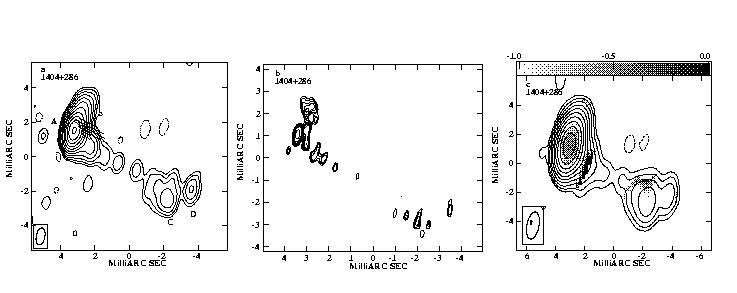Astronomy Object of the Month: 2020, February
< previous Archive next >
CSO radio sources and efficiency of their jets
The international team headed by astronomers from the Jagiellonian University has published detailed
research on the jet production efficiency in a sample of 17 selected young radio galaxies, for which the
observed luminosities of their jets, radio lobes and accretion disks seem to correspond to the same
episode of the central activity of their parent galaxies.
Compact radio galaxies typically exhibit concave radio spectra, with flux density maxima spanning a narrow
frequency range from 0.5 up to 10 GHz. Among them, we can additionally classify so-called
CSOs (Compact Symmetric Objects). Imaged with high resolution radio interferometers, they display
axially symmetrical radio morphologies consisting of two opposite lobes of radio emission, slightly similar
to much more extended radio lobes
often occurring in the
FR II-type radio sources, but with a span of not more than 1 kiloparsec in total (for comparison, FR II-type
sources often reach linear sizes of several hundred or even thousands of kiloparsecs). With such small sizes,
these structures must be formed within their host galaxies.

If such compact and symmetrical radiogalaxies are observed on radio waves for many years, it is possible to measure the expansion velocities of so-called hot spots - areas of strong radio emission moving away from the center of the active host galaxy (AGN) as the young radio source grows with time. These velocities are considered to be a good indicator of the time elapsed since the jet formation - more reliable than the ages of radio sources derived from the analysis of their aging synchrotron emission spectra.

Illustration 2: Upper panel: Distribution of the known CSO radio galaxies in the so-called Fundamental Plane for the black hole activity (Merloni et al. 2003). Sources from the examined sample are marked by red squares (filled for Compton-thin sources, empty for Compton-thick objects). The corresponding best-fit regression line is shown as a black solid line. Lower panel: same, except that here for the analyzed objects the monochromatic core radio fluxes are used. Credit: The Authors.
For this sample, the team analyzed the available optical spectra from the SDSS catalog, making it possible to estimate the bolometric luminosities of the galactic accretion disks. Masses of their central black holes were determined on the basis of measured dispersions of stellar velocities in the host galaxies. The minimum jet powers for the sample were determined using the estimates of their kinematic ages, assuming energy equipartition between magnetic field and radio-emitting electrons within compact lobes. It turns out that in most cases, these minimum kinetic luminosities of the jets are an order of magnitude lower than the corresponding jet powers determined with the independent method of calorimetric radio scaling - which, according to the team, overestimates the jet powers in young radio sources.
The estimated minimum jet powers, along with the known kinematic ages of the analyzed sources, provide the lower limit for the total energy deposited by the jets in central regions (within a radius of up to 1 kiloparsec from the center) of the parent galaxies. The dispersion of these quantities suggests that the most powerful of young radio sources may significantly affect the evolution of central bulges in their hosts, ie. galaxies observed at visible light.
The jet production efficiencies determined for the investigated sample sources prove that the newly-born, young radio galaxies most likely do not reach the highest possible level of the jet production efficiency, which can be expected in the case of highly magnetized accretion discs surrounding the fastest spinning black holes.
Original publication: A. Wójtowicz, Ł. Stawarz, C.C. Cheung, L. Ostorero, E. Kosmaczewski, A. Siemiginowska, On the Jet Production Efficiency in a Sample of the Youngest Radio Galaxies, ApJ, 2019.
Presented results are a part of research conducted at the Department of High Energy Astrophysics of the Jagiellonian University’s Astronomical Observatory. The work was supported by the Polish National Science Centre through the grant NCN 2016/22/E/ST9/00061.
|
Anna Wójtowicz Astronomical Observatory Jagiellonian University A.Wojtowicz [at] oa.uj.edu.pl |


